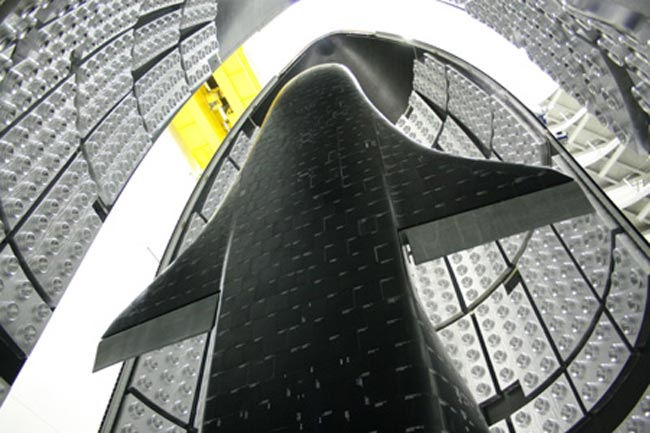Air Force's New X-37B Space Plane Likely an Orbital Spy
by Jeremy Hsu, SPACE.com Senior Writer
19 May 2010
A robotic Air Force space plane that launched in late April under a shroud of secrecy is most likely an orbital spy vehicle, and not a space weapon or weapon platform, a former U.S. Air Force officer says in a new report.
The reusable unmanned X-37B space plane would barely have any advantages as a carrier of space weapons, according to Brian Weeden, the former U.S. Air Force orbital analyst and now technical advisor for the Secure World Foundation.
"Certainly that's a possibility, but I don't see any evidence that it's being used like that," Weeden said. "The problem is being so hush-hush about what its mission is, and not disclosing the mission on orbit and not disclosing where it is in orbit."
The sense of mystery surrounding the X-37B's first spaceflight last month led to speculation about new U.S. space weapons, with some space technology experts contending it could contribute to worries among other nations such as Russia and China over U.S. space military capabilities. Gary Payton, Air Force deputy undersecretary of space programs, previously dismissed rumors that the X-37B space plane, known as the Orbital Test Vehicle 1, is the vanguard for a space weapon fleet. The reusable space plane is the first vehicle since NASA's space shuttles to have the ability to return experiments or hardware to Earth for inspection, Air Force officials have noted.
That unique capability will grow only rarer once the final space shuttle missions are flown over the next half-year or so, which may have encouraged the Air Force to order a second X-37B -- the Orbital Test Vehicle 2 -- slated to fly in 2011.
A flexible space spyship
An X-37B fleet would probably prove most useful as recon vehicles that could land and get new sensor configurations for different missions, Weeden explained. The space planes could also maneuver more than satellites can in order to adjust their orbits and provide flexible coverage of different areas on the ground.
"Let's say something pops up in area X in some part of the world, and a ground commander needs some capability there: [the X-37B] could configure and launch into an orbit that's optimized to cover that," Weeden told SPACE.com.
Having a smaller shuttle-like vehicle would also allow the Air Force to test new hardware or sensors in orbit, possibly for later launch aboard recon or spy satellites. That would give such equipment a much-prized "space heritage" or proven ability to function in space, which eliminates uncertainty and the costs of possibly launching something that doesn't work as intended.
The X-37B also has the ability to carry Operationally Responsive Space (ORS) satellites into orbit, in case the U.S. military needs situational awareness in a new area.
Not a space repair droid
But there are also some limitations, Weeden said, given that the space plane's payload size is roughly equivalent to a pickup truck bed. That means it likely would not find a good fit serving as a retrieval or repair ship for satellites.
The space shuttle's payload bay, by contrast, is huge. It could fit two entire X-37Bs inside.
"Once you put an arm and other equipment into the [X-37B] payload, how much room is left to put the satellite you capture?" Weeden pointed out. "Most military satellites are really big."
Even using the space plane to launch smaller satellites would be much less cost-effective than just several ORS payloads on their own rocket booster, Weeden concluded.
He estimated the cost of a single space plane launch as being about $100 million based on the average cost of the Atlas V rocket that blasted off with the first X-37B. That's more than the entire ORS budget for 2010 and beyond.
The same payload and cost-effectiveness restrictions would also make roles such as satellite inspection and repair less likely, Weeden said. But other nations can also take comfort from the fact that the X-37B is unlikely to grapple with any of their satellites as well.
Secrecy and paranoia
As for space weapon capabilities, Weeden rated that likelihood as "zero."
The payload restrictions would make it difficult for an X-37B to deploy hyperkinetic weapons which travel at high speeds with pinpoint accuracy, given that any weapon would require big thrusters to perform a de-orbit burn for reentry into Earth's atmosphere.
The X-37B also reenters like the space shuttle landing at about 200 mph and would glide down as a slow moving, not-very-maneuverable target that could easily fall prey to air defense systems.
Still, the many other possibilities offered by the X-37B have made it attractive for the U.S. military, Weeden said. But that same range of possible roles has also made nations such as Russia and China nervous.
The United States remains the only nation with global space situational awareness based on an array of satellites and ground sensors, which means that other nations can't check up on the X-37B's activities and divine its true purpose.
"I absolutely think this is the case [where secrecy is not always good], especially when it's clearly dual use and clearly going to upset some people," Weeden noted.
Weeden suspects that the X-37B currently circling somewhere overheard may be doing experiments for the National Reconnaissance Office, which operates U.S. spy satellites. And that could explain the Air Force's currently sealed lips about the mission.

A belly view of the U.S. Air Force's X-37B Orbital Test Vehicle as it sits inside its payload fairing during encapsulation at the Astrotech facility in Titusville, Fla., before its planned April 2010 launch. CREDIT: USAF